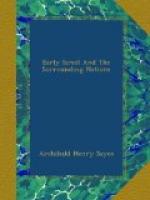The historical novel was an Egyptian invention. Several of the works that have survived are examples of it. But light literature of every kind was much in fashion. A tale written for Seti II. when he was crown-prince contains an episode which closely resembles the history of Joseph and Potiphar’s wife, and the reign of Ramses II. produced a sarcastic account of the misadventures of a tourist in Canaan, the object of which was to ridicule the style and matter of another writer. Poetry—heroic, lyrical, and religious—flourished, and a sort of Egyptian Iliad was constructed by the poet Pentaur out of a deed of personal prowess on the part of Ramses II. during the war with the Hittites.
Reference has already been made to the work on mathematics that was composed when the Hyksos were ruling Egypt. A century or two later a work on medicine was written, a copy of which is known as the Ebers Papyrus. It shows that medicine has not advanced very rapidly since the age of the Eighteenth Egyptian dynasty. Diseases were already carefully diagnosed and treated, much as they are to-day. The medical prescriptions read like those of a modern doctor; we have the same formulae, the same admixture of various drugs.
The Egyptians were not only a people of scribes and readers, they were also a people of artists. They had the same power as the Japanese of expressing in a few outlines the form and spirit of an object; their drawing is accurate, and at the same time spirited. It is true that their canon of perspective was not the same as our own, but the greater difficulties it presented to the artist were successfully overcome. Their portraits of foreign races are marvellously true to life, and their caricatures are as excellent as their more serious drawings. It was in statuary, however, that the Egyptian artist was at his best. The hardest of stones were carved into living likenesses, or invested with a dignity and pathos which it is difficult to match. Such at least was the case with the statuary of the Old Empire, before the conventionalised art of a later day had placed restrictions on the sculptor and stifled his originality. The great statue of King Khaf-Ra of the Fourth dynasty, seated on his throne with the imperial hawk behind his head, is carved out of diorite, and nevertheless the sculptor has thrown an idealised divinity over the face, which we yet feel to be a speaking likeness of the man. The seated scribe in the Museum of Cairo, with his high forehead, sparkling eyes, and long straight hair divided in the middle, has a countenance that is the very ideal of intellectuality, and in the wooden figure of the “Shekh el-beled,” we have an inimitable portrait of the sleek and wealthy bourgeois as he walks about his farm. All these statues are older than the Sixth dynasty.




